Inferior Mirages
© Charles ChandlerMirages are common occurrences, but they are not fully understood. They are assumed to result from light that passes through a density gradient, which refracts the light like a prism, except that instead of there being a sharp change in density at a gas-solid boundary, there is a density gradient entirely within the gas. In the Earth's atmosphere, if cooler, heavier air is at the bottom, light is refracted toward the Earth, creating what is known as a superior mirage. The same thing happens if there is a layer of hot air at the bottom, refracting light away from the Earth, in an inferior mirage. (See Figure 1.)The temperature gradient that produces inferior mirages is extraordinary.1Last summer we took some temperature measurements under the steady conditions prevailing at the epoch of diurnal maximum temperature above an asphalted road where inferior mirage could be seen on any clear day. The temperature variation with height above a hot surface was shortly afterwards measured also in the laboratory. The lapse-rates were of the order of 20~30 °C/cm in the first centimeter, and of the order of 1~2 °C/cm at higher levels near a heated surface. The observations showed that there was a "skin layer" within the first centimeter, and a "surface layer" extending up to about 20 cm above the hot surface. The variation of temperature above these layers is practically negligible compared to the much larger variations below.These results are displayed in Figure 2. Such an extreme temperature inversion is actually quite odd. The density of air at 20 °C is 1.2 kg/m3, while at 90 °C, it's 0.97 kg/m3. So the cooler air is 24% heavier than the warmer air, yielding 2.25 N/m3 of buoyancy. This should produce a vigorous exchange of air, eliminating the huge disparity in temperatures. In simulations, with a burner at 100 °C covering 10 km2, and 20 °C air above it, convection begins shortly after the burner is turned on, and quickly resolves into a series of Rayleigh-Bénard convection cells, roughly 100 meters wide, and 50 meters tall. The air picks up 3~4 °C traveling along the burner toward the central updraft in the nearest cell. Then the heated air rises to roughly 50 meters above the surface. The void left by the updraft pulls neighboring air downward, which itself gets heated as it travels along the surface. The result is a continuous recirculation of air, moving at roughly 1~2 m/s. And a hotter burner (or a better heat transfer mechanism) wouldn't increase the temperature gradient. Rather, it would merely result in smaller cells, because the determining factor is how much buoyancy the air can absorb before an updraft becomes inevitable. So we have no reason to expect any sort of substantial accumulation of thermal energy in the "skin layer", or even the 1~2 °C/cm gradient in the first 20 cm. Rather, it should be 3~4 °C total, distributed through the full depth allowed by the heat transfer mechanism (i.e., turbulence in the boundary layer).All the more curious is the fact that anyone who has stood in the middle of a road in the conditions that produce mirages knows that there actually isn't any convection. 1~2 m/s is walking speed, and air moving at such a speed is noticeable, yet the convection doesn't happen, and by the laws of thermodynamics, this simply isn't possible. 2.25 N/m3 of buoyancy should drive a vigorous updraft, and yet there is none. Clearly, we're missing something. Buoyancy is a force. If it is not having its expected effect, then an opposing force must be present. So what other forces are present?Other than the thermodynamic factors already mentioned, there is only one other set of forces in the atmosphere: electromagnetism. Since the air is only infinitesimally responsive to the magnetic force, we can focus all of our attention on the possible effects of just the electric force.Here it's significant to note that poorly conducting soils (such as sand in the desert, and asphalt) are better at creating inferior mirages. What would conductivity have to do with it?It's possible that the sunlight ionizes the surface of the Earth. The loss of electrons leaves the Earth with a positive charge. A net positive charge would only be possible in poorly conducting soil. (With higher conductivity, lost electrons would be quickly replaced from the Earth's vast electron cloud.) Some of the electrons liberated from the soil will get captured by molecules in the air, producing negative ions. These molecules will then be attracted to the soil by the Coulomb force. Their presence in the boundary layer will make it more difficult for air to rise. In other words, if 1 molecule per million is a negative ion attracted to the ground, then hotter, less dense air heated by contact with the surface will encounter a drag force as it rises, coming from the embedded negative ions. This will result in a higher temperature near the surface than is predicted by thermodynamics alone.If we explore the implications of another anomaly, we can increase the specificity of the model. Over the desert, the air is generally pretty dry, and this is one of the prerequisites for inferior mirages. Yet the diatomic molecules in dry air (N2 and O2) are really bad at absorbing infrared radiation. This suggests that heat can only be transferred from the ground to the air by direct contact, but such is a very inefficient mechanism. Yet even in the desert there is some water vapor in the air, where the primary source is evaporation from the ground. And water molecules are much better at accepting infrared wavelengths. The molecules then transmit the heat to neighboring molecules in collisions. Thus it's much easier to heat the air if water vapor is present. Interestingly, water molecules are also much more stable as negative ions that N2 and O2. Hence it's possible that as the sunlight heats the surface of the Earth, and water begins to evaporate, the sunlight also photo-ionizes the surface, and some of the liberated electrons are captured by water molecules. If so, the water vapor will be attracted to the Earth by the Coulomb force, and thus it will be the source of the drag force that results in an accumulation of hot air near the surface. The water vapor also absorbs infrared radiation from the surface, and distributes the heat in molecular collisions, becoming the primary cause of hot air.To test this, the temperature, humidity, and space charge needs to be measured. The present thesis asserts that all of these factors will be closely coupled.As concerns the optical properties of inferior mirages, the refractive model might not hold up under further scrutiny.2 For example, cars can drive through mirages without disturbing them, and there's just no way that the air in the lee of the car would not be thoroughly mixed. So there are actually two mysteries here, which might be unrelated — there is the anomalous temperature gradient that had no thermodynamic explanation, and then there is the anomalous bending of photons, which is typically attributed to the temperature gradient, but which might actually have a different set of causes.
References
1. Ramdas, L. A.; Malurkar, S. L. (1932): Surface convection and the distribution of temperature near a heated surface. Nature, 129: 201-202 ⇧
2. Zhou, H. et al. (2011): Road surface mirage: A bunch of hot air? Chinese Science Bulletin, 56 (10): 962-968 ⇧












